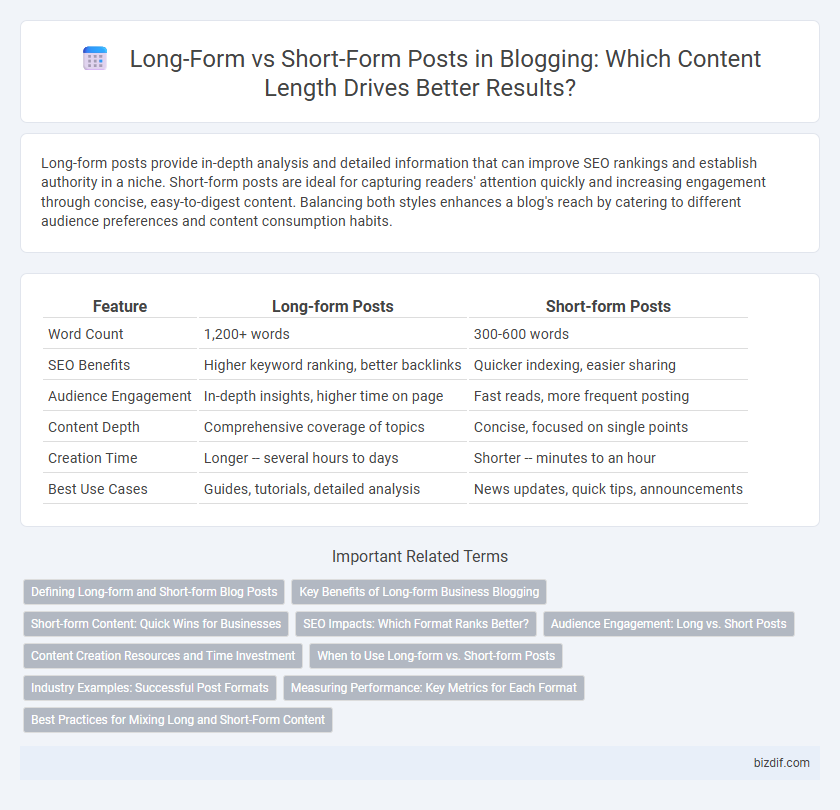Long-form posts provide in-depth analysis and detailed information that can improve SEO rankings and establish authority in a niche. Short-form posts are ideal for capturing readers' attention quickly and increasing engagement through concise, easy-to-digest content. Balancing both styles enhances a blog's reach by catering to different audience preferences and content consumption habits.
Table of Comparison
| Feature | Long-form Posts | Short-form Posts |
|---|---|---|
| Word Count | 1,200+ words | 300-600 words |
| SEO Benefits | Higher keyword ranking, better backlinks | Quicker indexing, easier sharing |
| Audience Engagement | In-depth insights, higher time on page | Fast reads, more frequent posting |
| Content Depth | Comprehensive coverage of topics | Concise, focused on single points |
| Creation Time | Longer -- several hours to days | Shorter -- minutes to an hour |
| Best Use Cases | Guides, tutorials, detailed analysis | News updates, quick tips, announcements |
Defining Long-form and Short-form Blog Posts
Long-form blog posts typically exceed 1,200 words and provide in-depth analysis, comprehensive insights, and detailed information on a specific topic, enhancing SEO through extensive keyword usage and higher user engagement. Short-form blog posts usually range from 300 to 600 words, offering concise, focused content aimed at quick consumption and frequent updates, which benefits sites prioritizing volume and immediacy. Understanding the distinction between long-form and short-form blog posts helps optimize content strategy for targeted audience engagement and search engine performance.
Key Benefits of Long-form Business Blogging
Long-form business blogging enhances SEO by providing in-depth content rich with relevant keywords, increasing time spent on page and improving search engine rankings. It establishes authority and trust with readers by thoroughly addressing complex topics, which boosts brand credibility and customer loyalty. Comprehensive posts also attract more backlinks and social shares, amplifying organic reach and driving sustained traffic growth.
Short-form Content: Quick Wins for Businesses
Short-form posts drive rapid audience engagement with concise, impactful messages tailored for social media platforms and email marketing. Businesses gain quick wins by increasing content frequency, improving SEO rankings, and capturing immediate attention from mobile users. This agile content format boosts brand visibility and supports faster conversion rates through targeted calls-to-action.
SEO Impacts: Which Format Ranks Better?
Long-form posts, typically exceeding 1,500 words, often outperform short-form posts in SEO due to comprehensive coverage of topics, higher keyword density, and increased dwell time. Search engines favor in-depth content as it demonstrates expertise and authority, resulting in better rankings on SERPs. However, short-form posts can rank well for highly specific queries or trending topics when optimized with targeted keywords and clear intent.
Audience Engagement: Long vs. Short Posts
Long-form posts, typically exceeding 1,200 words, tend to boost audience engagement by providing in-depth information, encouraging longer time spent on the page, and fostering better SEO performance. Short-form posts, usually under 600 words, cater to readers seeking quick insights and higher shareability on social media platforms. Balancing post length with target audience preferences and content goals enhances reader interaction and overall blog effectiveness.
Content Creation Resources and Time Investment
Long-form posts demand substantial content creation resources, requiring extensive research, detailed analysis, and careful structuring to maintain reader engagement over several thousand words. Short-form posts, by contrast, consume significantly less time and resources, allowing for quicker publishing schedules and more frequent updates. Efficient allocation of time and resources ensures content strategy aligns with blog goals, balancing depth and consistency.
When to Use Long-form vs. Short-form Posts
Long-form posts, typically exceeding 1,200 words, are ideal for in-depth analysis, comprehensive guides, and detailed case studies that require thorough explanation and multiple sections. Short-form posts, generally under 800 words, work best for quick updates, news, or simple tips that engage readers with concise information and faster consumption. Choosing the right format depends on the topic complexity, audience engagement goals, and the desired SEO impact, with long-form content often driving higher search rankings and user retention.
Industry Examples: Successful Post Formats
Long-form posts, often exceeding 2,000 words, dominate industries like technology and finance, with companies such as HubSpot and Neil Patel showcasing in-depth guides that boost SEO rankings and user engagement. Conversely, short-form posts under 600 words excel in dynamic sectors like news and entertainment, where BuzzFeed and Mashable leverage concise, easily digestible content to maintain high traffic and rapid sharing rates. Both formats demonstrate strategic success by aligning content length with audience preferences and platform algorithms, optimizing visibility and interaction.
Measuring Performance: Key Metrics for Each Format
Long-form posts typically demonstrate higher engagement rates, with average time on page exceeding 5 minutes and lower bounce rates compared to short-form content. Short-form posts often yield more social shares and quicker page views, making click-through rate (CTR) and shareability key performance indicators. Analyzing metrics such as conversion rate, dwell time, and scroll depth helps optimize both formats based on audience behavior and content goals.
Best Practices for Mixing Long and Short-Form Content
Balancing long-form and short-form posts enhances user engagement and SEO by addressing diverse reader preferences and search intents. Long-form content, typically over 1,200 words, provides in-depth information and establishes authority, while short-form posts under 600 words offer quick insights and maintain consistent posting frequency. Integrating both formats strategically improves content variety, boosts organic traffic, and nurtures audience retention across multiple platforms.
Long-form Posts vs Short-form Posts Infographic

 bizdif.com
bizdif.com